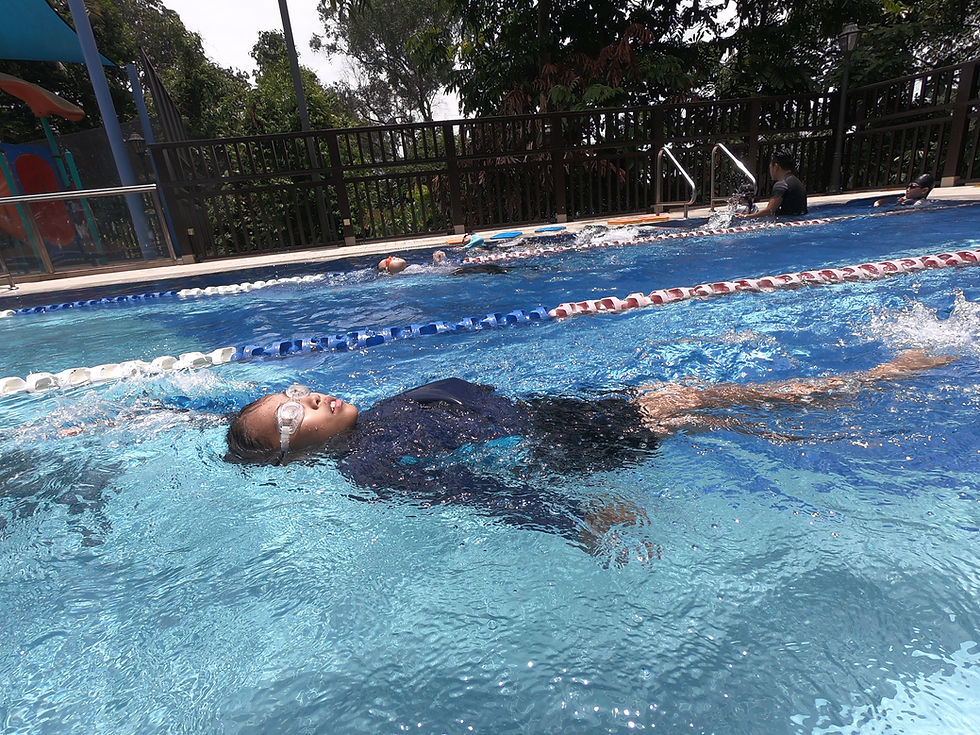Self-Taught Backstroke: Training for Different Water Conditions
- SG Sink Or Swim

- Jul 31
- 3 min read

Teaching yourself backstroke can be both empowering and rewarding. But as you take your swimming to new environments — from calm pools to unpredictable open waters — it's crucial to adjust your technique and mindset. Different water conditions demand different strategies, especially when training solo.
In this article, we’ll walk through how to train backstroke independently in various water environments and how to adapt your form, drills, and focus for maximum success.
🏊♂️ Why Backstroke Requires Adaptability
Backstroke is the only competitive stroke done on the back, which brings unique challenges:
You can’t see where you’re going.
You’re more vulnerable to wind, chop, and waves.
Your stroke rhythm must remain consistent even in changing environments.
To master backstroke in different conditions, you’ll need to train your balance, spatial awareness, breathing control, and stroke consistency across diverse scenarios.
🌊 1. Backstroke in a Calm Pool (Ideal for Beginners)
This is your baseline training environment. A pool gives you the structure to work on:
Body position and alignment
Stroke timing and technique
Wall tracking for turns
Counting strokes per length
Key Drills:
Single-arm backstroke with streamline kick
6-3-6 drill (6 kicks, 3 strokes, 6 kicks)
Stroke counting sets to build distance-per-stroke awareness
🎯 Use lane markings or ceiling beams to stay straight and develop spatial awareness.
🌬️ 2. Backstroke in a Windy or Outdoor Pool
Wind creates surface chop, which can disrupt your hand entry and body position.
What to Focus On:
Clean hand entry with pinky first to avoid slapping water
Low, controlled arm recovery
Strong, steady flutter kick for added stability
Key Tip:
Use a tempo trainer to maintain consistent stroke rhythm when conditions feel off.
🌊 3. Backstroke in Lakes or Calm Open Water
With no lane lines or walls, staying straight and oriented becomes the biggest challenge.
Strategies:
Sighting every 6–8 strokes by rolling slightly to look backward for landmarks
Swim along a shoreline or use a visible object (trees, buoys, buildings) as a reference
Focus on head stability to reduce zig-zagging
Key Drills:
Partner-assisted straight-line swims: Have someone swim nearby or kayak parallel
Backstroke pull with snorkel: Keeps your head still while reinforcing bodyline
🎯 Practice in short loops before building to longer distances.
🌊 4. Backstroke in Wavy or Choppy Water
In surf or wind-churned water, maintaining control is everything.
Adjustments:
Increase kick intensity to stabilize your body
Use fewer but stronger strokes to maintain direction and control
Keep a lower recovery to reduce arm drag from the wind
Drill:
Resisted backstroke with drag shorts or parachute in the pool to simulate rough water
🚨 Safety first: Always swim with a spotter or in a group in open water.
🧠 Additional Tips for Self-Learning Backstroke in All Conditions
Record your swims: Use a waterproof camera to review form and alignment
Use stroke-count benchmarks: Know your average strokes per 25m and use it as a guide when you can’t see the wall
Visualize turns and finishes if you’re training without a wall
Mix training locations weekly to build true adaptability
🏁 Final Thoughts
Backstroke is a powerful, graceful stroke — and with the right strategies, you can train and master it on your own, regardless of the water conditions. By practicing consistently in various environments, focusing on alignment, and adapting to challenges like chop or limited visibility, you’ll become a stronger, smarter backstroker.





Comments